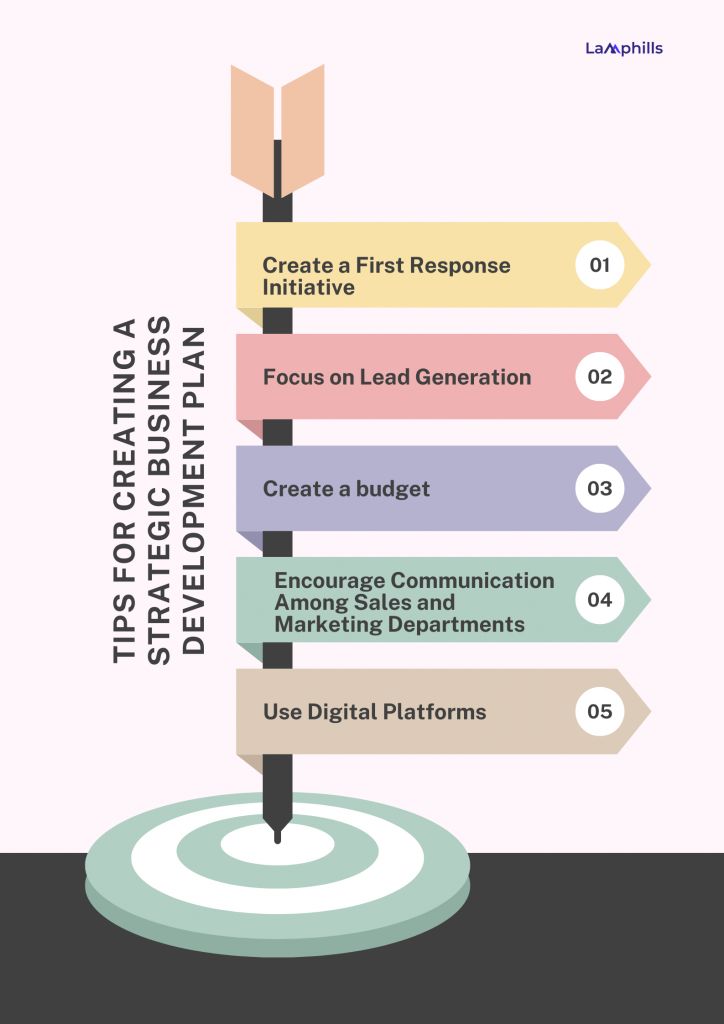Is your business struggling to grow and land new customers? You’re probably missing a solid business development plan.
Successful businesses don’t leave growth up to chance. They have a systematic approach to developing new businesses lined up. That’s what a business development plan does.
Without one, you’ll keep struggling and scratching for ways to find new customers and clients. A solid plan aligns your team around the specific markets, prospects, services, and marketing tactics to drive sales.
So, in this guide, I will show you exactly how to create a great business development plan step-by-step.
Key Points
- Networking with individuals of your target demographic can generate new business
- Showcase the value proposition of the organization’s offerings, emphasizing important benefits and strategic advantages
- Always think about the timing of your reaction and try to reach out as soon as possible
- Looking for leads is also a wonderful approach to staying connected with your possible consumer base
- Examining your present customer base will help you refine your consumer profiles
What is a Business Plan?
A business plan is a document that describes your company’s operations, revenue streams, and customer base. Creating a company plan can help you clarify your vision and structure your operations internally. Externally, you might share it with potential lenders and investors to demonstrate that you are on the correct path.
Business plans are live documents, which means they can alter over time. Startups may frequently revise their business strategies as they learn more about their clients and what products and services would best suit them. At the same time, mature organizations may only review their business plans every few years.
What is a Business Development Plan
A business development plan involves identifying, attracting, and obtaining new business to help your firm achieve its revenue and growth objectives. Achieving these objectives is commonly referred to as a business growth strategy, and it affects and benefits everyone in your firm.
It is not uncommon to confuse business growth with sales, yet there is a significant difference between the two. Business development encompasses various activities and functions within and beyond the standard sales team structure. In some organizations, business development is part of the bigger sales operations team. In others, it is a marketing team member or has its own team entirely.
Because business development can look very different among industries and businesses, the strategy for this job is broad. Each step of the strategy is outlined below, along with how to apply it to your business development plan.
Tips for Creating a Strategic Business Development Plan

To efficiently create a strategic corporate development plan, follow these guidelines:
#1. Create a First Response Initiative
Define how to contact and follow up with new leads in your business growth plans. Always think about the timing of your reaction and try to reach out as soon as possible. Successful business development is often achieved by implementing well-defined initiatives and strategies.
Now that I’ve defined strategic business development and explained why it’s vital, you’ll be better equipped to establish and implement a strategic business development strategy.
#2. Focus on Lead Generation
As an experienced business writer, I always advise my clients that when implementing strategic business development plans, they should strive to identify potential buyers for their product or service. Consider generating leads with social media ads and call-to-action buttons on websites. Focusing on lead creation can make it easier to close sales if prospective clients are interested in your items. Looking for leads is also a wonderful approach to staying connected with your possible consumer base.
#3. Create a budget
Also, it’s important to know that before implementing your ideas, you must identify the scope and expense of your projects. This allows you to stay within your budget and identify when you overspend. A budget lets you decide whether your strategic business development plans are worth the expenditure. For example, if the financial impact of your plans exceeds the expected returns, you may need to reconsider your business development strategy and techniques.
#4. Encourage Communication Among Sales and Marketing Departments
Implementing a strategic corporate development plan effectively takes a team effort. Increasing communication between the sales and marketing teams will help you reach your strategic business objectives. These campaigns can be more effective and generate well-organized leads. Organize team meetings and brainstorming sessions to create business development strategies and find long-term growth opportunities.
#5. Use Digital Platforms
Improving your web presence is a valuable component of any business development strategy. Increase brand exposure and trust with social media and digital content. Digital platforms can also help you track your customers’ demographic information. For example, you may use website traffic to better understand how your target audience interprets advertising campaigns and reacts to new products.
How to Write a Business Development Plan
You may wonder where to begin if you’ve decided to create your business development plan (or update one you already have). Let me walk you through the steps.
#1. Establish Clear Financial Goals
Your business development strategy should include specific financial goals. For example, every firm wants to boost sales, yet this is not a particular goal. Instead, create a sales objective for a specific term and make it realistic by using your present numbers as a benchmark.
To do so, forecast your sales, profit, and expenses, assuming no changes to the business. Then, consider a reasonable target and include it. This number could be lower than you think.
#2. List the Financing Sources
Your plan should include the amount of cash you’ll require and how you intend to obtain it—loans, equity investors, or crowdfunding, for example. Now is the moment to develop a detailed finance strategy. Doing this legwork ahead of time while designing your plan allows you to focus on execution when stress sets in.
This plan section should contain your secured sources and those from which you’d like to seek financing. It should also specify how much you want to pursue from each source, what form that money will take, and any hurdles you may meet.
#3. Determine the Operating Needs
Be mindful that your business expenses will rise when your operational requirements grow. For example, you may need extra equipment, a larger warehouse to accommodate increased logistics, or more people to assist clients. Whatever it is, include it in your business development strategy.
#4. Create a Sales and Marketing Strategy
Your business development plan is excellent for adding sales and marketing strategy. Finally, they will be some of the most important drivers in maximizing your growth potential and meeting your financial objectives.
As you write these concepts, put them through this basic test: Will they hold up if you meet your growth targets, or will you have to rethink them? Ideally, you want sales and marketing strategies that can grow together.
#5. Refine Customer Profiles
Detailed customer and audience profiles enable your company to target its marketing efforts successfully. Your business may already have client profiles; upgrading your business plan is also an excellent time to update these profiles. If you don’t already have a profile, there’s no better time than now.
Examining your present customer base will help you refine your consumer profiles. Examine their demographics and habits. Then, follow a similar process to construct profiles of your ideal customers.
#6. Create an Elevator Pitch
Your elevator pitch summarizes your company’s mission. The theory is simple: what would you say if you met someone in an elevator and just had a few seconds to pitch your company?
Some people set artificial constraints for their elevator pitch, such as limiting it to 280 characters, which is the length of a Twitter post. While this limitation is not required, it should help you understand the size of an elevator pitch and the impression you’ll need to make.
#7. Determine Your Resource Needs
You’ve defined your operations requirements, including equipment, facilities, and people. You’ll also want to determine your resource requirements. These include handling your technology and team members in a more specialized way.
Checklist on Best Business Development Plan.pdf
Steps To Developing a Business Development Plan
Let’s examine some of the most prevalent business development tactics and compare them to what today’s buyers want.
#1. Networking
Networking is the most common company development technique. It is based on the premise that buying decisions for professional services are influenced by relationships and that face-to-face networking is the best approach to building new ties.
I know of so many relationships that were formed in this way. Networking with individuals of your target demographic can generate new business. However, there are limitations. On the other hand, today’s buyers are extremely time-conscious, and networking takes time. It may get very expensive when you include travel and time away from the business.
#2. Marketing
Good marketing skills are required for business development. Marketing involves identifying ways to market a firm or brand and deciding what to give your target customer. Show off your marketing abilities by brainstorming ideas to raise your company’s awareness. Business awareness occurs when individuals emotionally engage with your services or products.
#3. Sales
Sales skills refer to your ability to identify a company’s target customer and successfully sell its products and services. These skills include cold contacting and scheduling in-person encounters. Sales skills are also required for estimating sales when creating a strategy plan.
#4. Effective Communication
Excellent communication skills are required for business development. You must speak clearly and relate to clients. Effective communication involves attentively listening to customers’ comments and meeting prospects’ needs. It is also crucial to demonstrate confidence in your business and accept constructive criticism. You can also use your written communication abilities when creating a business development plan.
#5. Business Intelligence
You must know that business intelligence refers to acquiring insights into the market area. In business development, these abilities include investigating a company’s needs and gathering and interpreting data.
#6. Referrals
Like networking, referrals are key to generating new business from satisfied clients. In my line of business, I’ve met many people who came to me by referrals. You build a relationship, and that person refers new business to you. Satisfied clients do the same thing.
Referrals are unquestionably common, and many businesses rely on them for most or all of their business. However, referrals are passive. They rely on your clients and contacts to find qualified prospects for your services and make referrals at the appropriate moment.
The difficulty is that referral sources frequently don’t understand the full extent of your services or the various ways you might assist a client. So many referrals are mismatched to your ability.
#7. Project Management
Running a business requires effective management, just like any other undertaking. The capacity to lead departments is crucial because you cannot tackle every duty alone. Project management abilities also include the capacity to oversee projects and manage risks successfully.
Steps in the Business Development Process
While the individual steps in the business development process will vary on the specific company, its requirements and capabilities, leadership, and available cash, the following are some of the more prevalent ones:
#1. Market Research and Analysis
Conduct extensive market research to learn about market trends, client needs, and the competition environment. Analyze data and obtain more information to identify new growth possibilities and better understand market trends.
#2. Establish Relationships and Present Solutions
Make touch with eligible leads and build relationships through effective communication and engagement. One of the basic steps in business development is to create trust and credibility, attend networking events and industry conferences, send personalized emails, or communicate on social media. Create and present unique solutions that meet the client’s needs as your connection develops. Showcase the value proposition of the organization’s offerings, emphasizing important benefits and strategic advantages.
#3. Continuously Evaluate
There’s this client of mine who, every week, continuously monitors and analyzes the success of his business development initiatives. He constantly analyzes the performance indicators, gets feedback from clients and internal stakeholders, and identifies opportunities for improvement. He refines tactics and processes regularly to keep up with market changes and maximize outcomes.
#4. Negotiate and Expand
These are also important aspects when it comes to business execution. Create and deliver proposals, including the scope of work, cost, deliverables, and timelines. Once an agreement is reached, coordinate with legal and other appropriate internal organizations to guarantee a seamless contract execution process.
#5. Set Clear Goals and Objectives
Using the study, establish precise objectives and targets for business growth initiatives. Such goals include revenue targets, market expansion goals, client acquisition, and product/service development objectives. Clear goals provide direction for the business development process.
#6. Generate and Qualify Leads
Generate a pool of possible leads using various sources, including industry databases, networking, referrals, and online platforms. Identify individuals or businesses that meet the target market characteristics and have the potential to become clients. Then, review and qualify leads using specified criteria to determine their suitability and potential value.
What is included in a business development plan?
A business development strategy consists of two primary parts: research, which involves learning more about your market, customers, and competitors, and action, which involves putting your research into action. This includes developing a value proposition, providing content, and experimenting with new ideas.
What are the 4 basic phases of a business plan?
All company plans should include the executive summary, marketing plan, key management bios, and financial plan. These four categories can be supplemented with others when targeting specific purposes and audiences.
What are some business development activities?
- Innovate your networking strategies.
- Offer consultations.
- Provide sales demonstrations to prospects and leads.
- Nurture prospects.
- Provide prospects with a variety of content.
- Communicate with Marketing.
- Invest in your website.
- Encourage your personnel to develop and perfect their talents.
Conclusion
Business growth allows organizations to rise above their day-to-day obstacles and chart a roadmap for a prosperous future. An increasing number of firms from various industries recognize its worth and importance.






